Bhaktapur Durbar Square
Bhaktapur Durbar Square is famous for the 55 Window Palace, National Art Museum, former Palace courtyards, Naga Pokhari, and many other architectural and cultural marvels.
Bhaktapur Durbar Square is famous for the 55 Window Palace, National Art Museum, former Palace courtyards, Naga Pokhari, and many other architectural and cultural marvels.
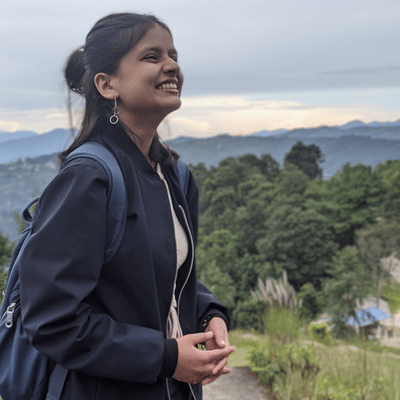
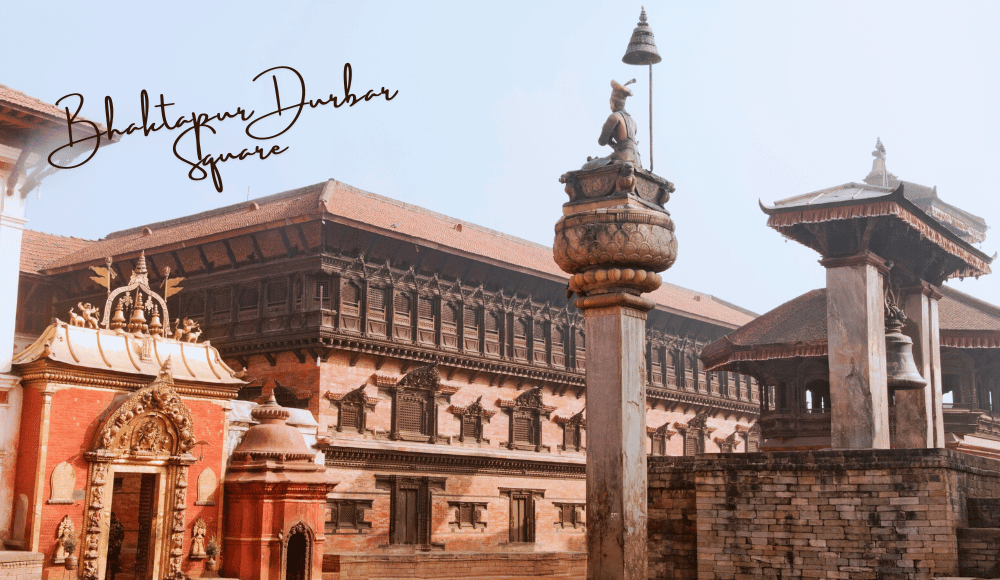
A place where time seems to have stood still, where the echoes of the past can still be heard in the bustling streets, Bhaktapur Durbar Square is a hidden gem tucked away in the ancient city of Bhaktapur, Nepal. As you step into the square, you’ll be teleported back in time to a world of ancient myths, kings, goddesses, and architecture that will leave you in awe.
Located 12 Km from the capital city, Bhaktapur Durbar Square is one of Nepal's three central royal squares alongside Patan Durbar Square and Kathmandu Durbar Square. Bhaktapur is the cultural capital of Nepal, the surrounding durbar squares being the living heritage of this ancient Newari town. This UNESCO World Heritage Site offers you the best chance to observe the culture and traditions of Nepal first-hand.
Imagine standing in front of the 55 Window Palace, a 15th-century masterpiece of traditional Newari architecture. You’ll be transported to a different era as you gaze upon its astonishing wood carvings in the 55 windows that give it its name. Or perhaps you will find yourself at the Golden Gate, the entrance to the palace complex. Adorned with intricate carvings of goddess Taleju, her attendants, and man-bird Garuda, it is a true testament to the metal craftsmanship of the Newari people.
The Nyatapola Temple, a towering five-story pagoda temple, dedicated to the Hindu goddess Siddhi Lakshmi, is another awe-inspiring architectural marvel. Built in 1702 AD, the steps of this temple are guarded by stone lions and wrestlers. As you climb these steps, you will feel a sense of reverence and amusement toward Nepal&rsquo's ancient culture and traditions.
In the Pottery Square, you can see traditional potters sculpting terracotta pottery using techniques passed down through generations. As you walk around the square, surrounded by traditional Newari houses and temples, you will get a glimpse into the local lifestyle and culture. You can’t help but feel a connection to Nepal’s ancient art and traditions.
The square is a bustling hub of traditional Newari life, with artisans plying their trades, vendors selling traditional handicrafts, and locals going about their daily lives. Join us as we delve into the history, architecture, and culture of Bhaktapur Durbar Square and discover the beauty and wonder of this incredible place.
|
Monument |
Bhaktapur Durbar Square |
|
City |
Bhaktapur |
|
Province |
Bagmati |
|
UNESCO World Heritage Site listed |
1979 |
|
Founded by |
Jayasthiti Malla |
|
Major Architectural Style |
Sikhara, Pagoda, and Newari Style (seen in most temples and monuments) |
|
Major Festivities |
|
|
Major Attractions |
|
|
Entry fees |
|
Bhaktapur is a city that will leave you enchanted, where history and culture collide in the most magical way. As you step into this ancient city, you will feel like you have been transported back in time to a place where grandeur and tradition reign supreme. With its many architectural marvels, Bhaktapur is often referred to as an open-air museum, and the Bhaktapur Durbar Square is the city's crown jewel.
The first Royal palace of Bhaktapur durbar square is believed to be built by King Jayasthiti Malla in the late 13th century. The palace was originally named Yuthuniman Rajkula. Although the palace of that time is not standing, the current palace still holds many stories and insights into the history and contributions of the various kings who have ruled here.
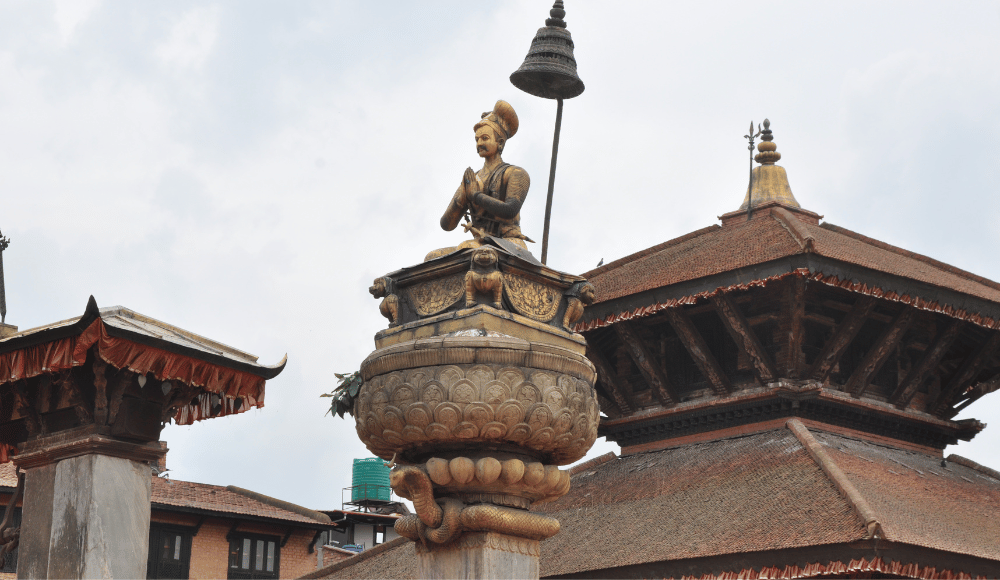
In the 15th century, the square was expanded by King Yakshya Malla, who also set the foundation for the 55 Windows Palace. The palace took 3 generations to complete and was finally completed in the 17th century during the rule of King Bhupatendra Malla. During the Malla era (12th - 18th century), the square was an important center of politics, where the kings held court and conducted important ceremonies and events.
In the 18th century, the Kathmandu Valley came under the rule of the Shah dynasty. They continued to patronize the arts and culture of Bhaktapur Durbar Square, but unfortunately, the square fell into disrepair in the 19th century. Only in the early 20th century were efforts made to restore and preserve the square’s historical buildings and temples.
Today, Bhaktapur Durbar Square, its Royal palace, and its surrounding squares are not just a must-see destination for history buffs, but also for anyone who wants to experience a journey back in time and immerse themselves in the rich culture and history of the city.
In Bhaktapur Durbar Square, the past and present come together in the most captivating and engaging way. You will be awe-struck every time you put your sight into a newer detail. It is a place where you can lose yourself in history, architecture, and culture and leave with a newfound appreciation for the rich heritage of Nepal. Let's go through some of those major sites in Bhaktapur Durbar Square.
The 55-Window Palace is one of the most iconic structures of Bhaktapur Durbar Square. Locally known as the Pachpanna Jhyale Durbar, it is a three-story building with a central courtyard that took over a century to be completed. Covered in intricate, detailed patterns and carvings, it is considered one of the most beautiful examples of Malla-era architecture.
The palace is a true marvel to behold, from the first floor with its traditional Newari architecture, wooden columns and beams, and delicate carvings and sculptures on the walls, to the second floor with its beautiful 55 windows, each intricately carved and decorated with traditional Nepali motifs. On the third floor, visitors can marvel at the large statue of the Hindu god Bhairava, considered the guardian of the city.
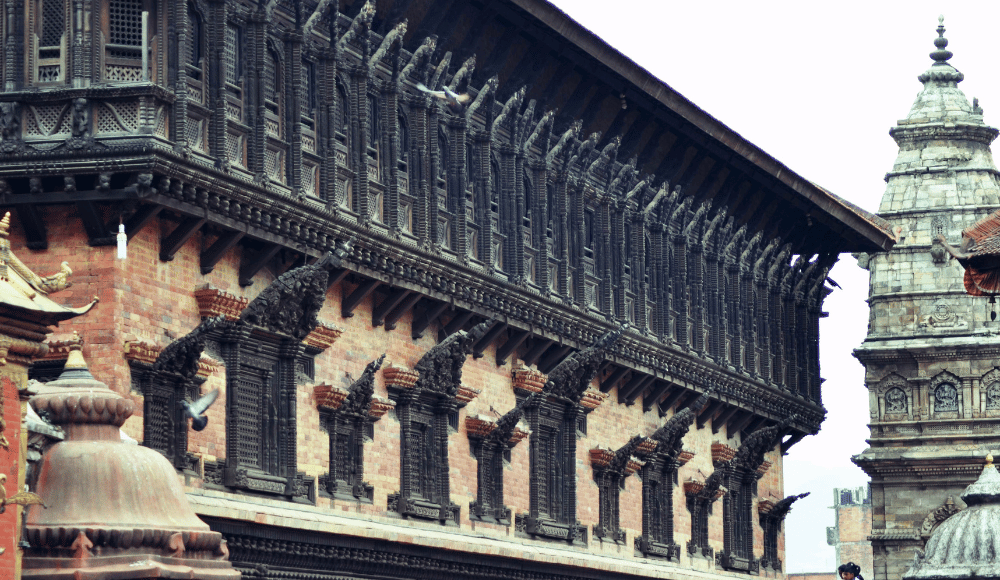
The palace served as an important center of politics during the Malla period. The Malla Kings held court and conducted important ceremonies and events there. Despite falling into despair from the earthquakes of 1934 and 2015, efforts were made to restore and preserve the 55-Window Palace and its historical temples and buildings.
The palace is also steeped in traditional Nepalese culture, with the 55 windows believed to symbolize the 55 different stages of the human life cycle. Similarly, the intricate carvings and sculptures on the walls depict traditional Nepal’s culture and belief system. The palace also features traditional Newari craftsmanship, and visitors can find many shops selling traditional handicrafts such as pottery, weaving, and woodcarving.
The National Art Museum of Bhaktapur Durbar Square is a treasure trove of Nepalese art and culture, with an impressive collection of over 4000 pieces of art and artifacts. The numbers include traditional paintings, sculptures, woodcarvings, metalware, and textiles from the 11th century to the present day. The collection spans a wide range of styles, from traditional to contemporary, and is a true reflection of the diversity and richness of Nepalese art and culture.
The National Art Museum was previously called Simhadhwoka Durbar, an ode to the two stone lions guarding the entrance to the building. The two lions are accompanied by stone statues of Hanumanta-Bhairava and Nar-Simha, welcoming visitors to the museum. Even though the palace building was built in 1698, it was turned into a museum only in 1960. Over the years, the museum has gone through several changes and unfortunately is not in its fundamental form after the earthquakes of 1934 and 2015.
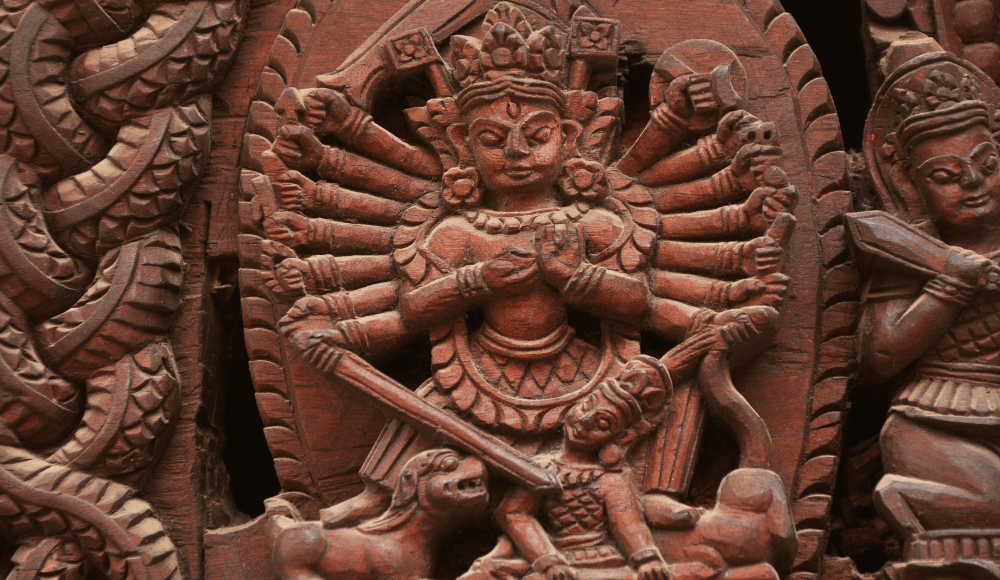
The ground floor of the museum consists of stone sculptures of several deities including Nava-Durga, four-handed Ganesha, Kubera, Vishnu, etc. This floor also displays paintings and sculptures of Hindu and Buddhist Gods and their consorts engaging in an extensive yogic union. The second floor, however, is dominated by paintings from different eras, centuries-old inscriptions, and images of kings and princes. One of the major highlights of the museum is the collection of traditional Nepalese Paubha paintings along with ancient chronicles and manuscripts. Paubha paintings are considered sacred and the finest examples of traditional Nepalese art, usually depicting scenes from Hindu and Buddhist mythology.
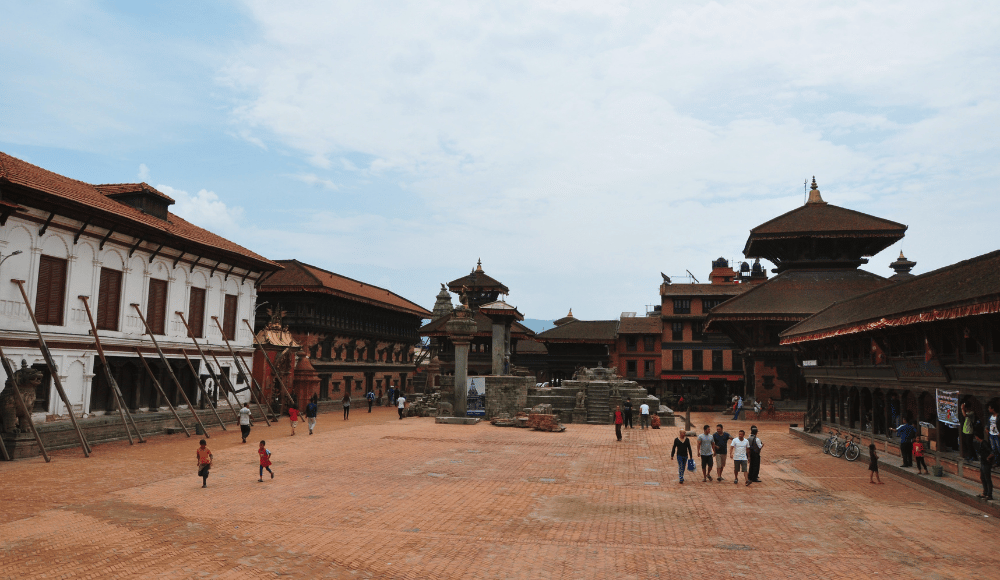
The National Art Museum’s collection is beautifully curated and provides an in-depth understanding of the history of Nepalese art and the cultural and religious influences that have shaped it. The museum also has a library with a wide range of reference books and publications about Nepal that visitors can purchase. You will have to pay an extra NRs 50 for a ticket to enter the museum. The ticket is valid for the other two museums of Bhaktapur. (The Wood carving museum and The Brass and Bronze Museum)
The Golden Gate, also known as Swornadwar (golden gate in Nepali), is one of the prettiest and most ornately decorated gates. The gate leads to the main courtyard of the 55 Window Palace, to the Taleju Bhawani Temple. The Golden Gate was built by King Ranjit Malla, the last king of the Malla Dynasty, in 1757. Despite being the last addition to Bhaktapur Durbar Square by the Malla kings, it is undoubtedly their best masterpiece.
The Golden Gate is made up of bronze and is gold-plated, hence giving it its name. Its roof is built in a mock-pagoda style with several religious symbols, deities, and inscriptions made on the gate. The main highlight of the Golden Gate is the statue of Taleju Bhawani at the top. The goddess is represented with 10 arms and multiple heads, holding a different weapon in each hand while also maintaining the “blessing” posture.
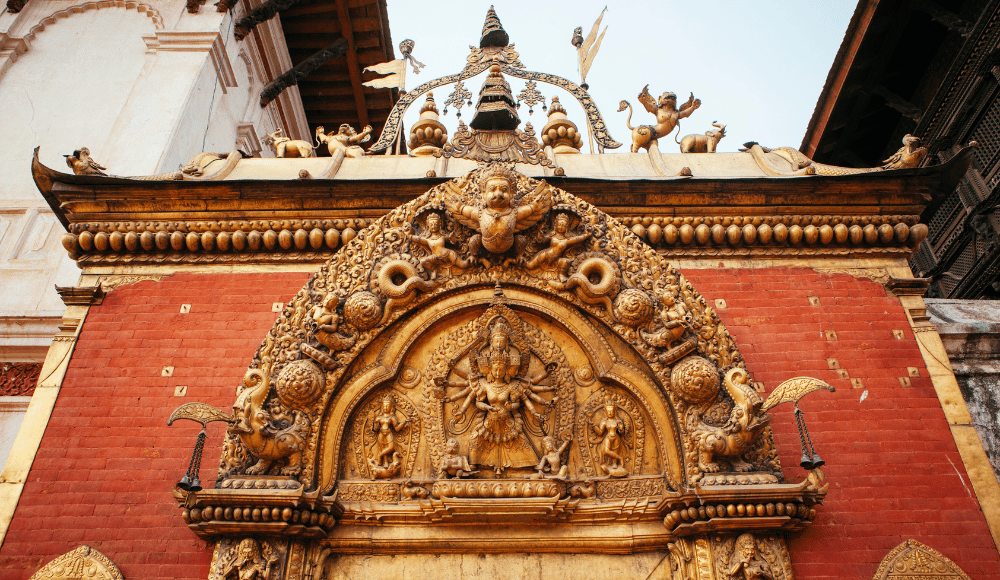
The guardian deity of Malla kings, Taleju Bhawani, is surrounded by her attendants at the gate. The man-bird Garuda can be seen on the very top of the gate with other semi-human semi-animal deities. The top of the Golden Gate also has two flags shaped like the National flag of Nepal. On the lower parts, there are Khwopa (sections) for other deities including Astamatrika, Ganesha, Purna Kalash, etc.
Golden gate is a combination of the best representations of Newa culture. It is a complete package of Nepalese art styles and architecture that cannot be described in mere words. You should definitely stop by the gate for a few minutes to take in all the details of this Swornadwar before you enter the palace complex.
Taleju Bhawani is the guardian deity of the Malla kings. She was brought to Nepal in the 14th century when the Malla Kings started ruling Kathmandu Valley. The Malla dynasty accepted most Newari culture and traditions, but Goddess Taleju remained unmoved as their clan goddess. She is said to be the goddess who made Kings, especially favoring the Malla Kings.
There are a lot of mythical stories revolving around Taleju Bhawani and her regular interactions with the kings. In one such interaction, she was angered by the lustful intentions of the then-king (who was also her favorite) and she stopped visiting him. The king begged and pleaded for her return. She agreed to return but in the form of a young, virgin girl of the Buddhist Shakya clan. That was the origin of the living goddess, Kumari, and the temple is dedicated to her and the deity she represents, Taleju Bhawani.
The Taleju Temple of Bhaktapur is the oldest of all Taleju temples in the Kathmandu Valley. It is believed to hold the original Yantra (symbolic form) of the goddess Taleju holding her heavenly abilities. The Taleju Temple lies on the Mul Chowk premises and consists of several shrines. It is beautifully decorated with colorful paintings and carvings on the walls. Taleju Bhawani is one of the most honored, preserved, and visited temples of the Kathmandu Valley.
Unlike the Taleju temple in Kathmandu and Patan Durbar Squares, the Taleju temple of Bhaktapur Durbar Square is open to visitors all year round. But do keep in mind, only Hindus are allowed inside the temple premise. Pictures and videos are strictly prohibited. You will have to take off any leather products and shoes before entering the temple. Make sure to follow the temple rules and have a fun visit.
Located just beside the 55 Window Temple, Siddhi Laxmi Temple is a Shikhar-style temple located on the far-eastern side of Bhaktapur Durbar Square. This temple is believed to protect against evil spirits and negative forces. This temple is dedicated to the goddess Siddhi Laxmi, a wrathful manifestation of the goddess Durga. You can see the faces of Durga mounted upon all the entrances of Siddhi Laxmi temple.
It is situated on a 15-stepped, diminishing pyramidal platform with 5 plinths. Each plinth has a pair of stone figures, consisting of humans, animals, and fanatical creatures. The first plinth (from the bottom) has a couple with a child and a dog. It is very fun to decipher the meanings behind these sculptures. They are followed by horses, rhinos, humanoid creatures, and camels. They sure are a unique set of statues to place together in a temple.
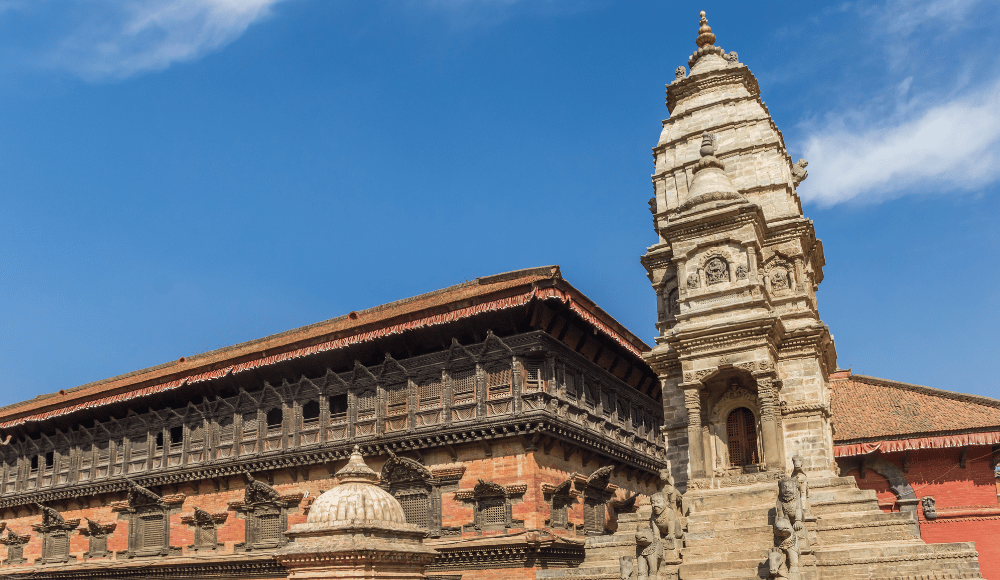
These stairs of Siddhi Laxi Temple are one of the most popular sites to take pictures in Bhaktapur. On a busy day, you might have to get in a queue to get a chance to click pictures there. But make sure you are not disturbing anyone’s Puja and rituals as it is a popular site for locals to worship in. Be respectful of other visitors as well as locals and admire this strange beauty.
Naga Pokhari, otherwise known as the Royal Bath, is a pond situated in the courtyard of Bhaktapur Durbar Square, just outside of Taleju Temple. It was built in 1678 AD by King Jitamitra Malla as a royal bath to the palace. Naga Pokhari is one of the many Hitis of Bhaktapur but stands out quite a lot due to its beautiful architecture and the giant stone snakes encircling the pond. There is another tall Naga in the middle of the bath, making the pond/bath more intimidating.
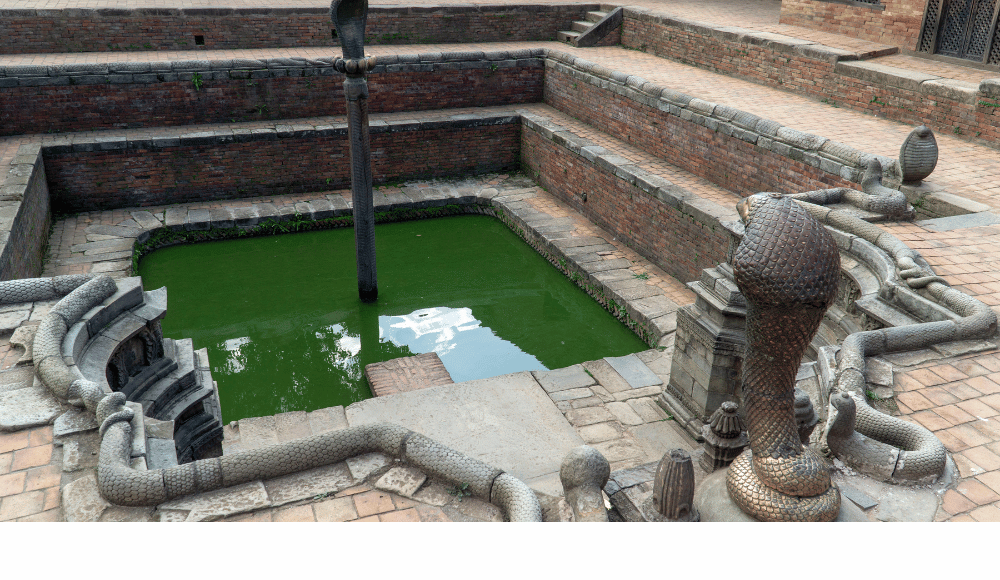
As one can tell from its name, the whole theme of Naga Pokhari is snakes; giant snakes. The entirety of this small pond is decorated with Naga(snakes) carved on stone surrounding the bath. Even the gilded stone spout, from where spring water is poured into the Hiti, has one of those Nagas. You can observe it in great detail if you walk down into the bath. It also contains details about this art and how the water serpent protects mortals from evil.
Yearly, the idol of Taleju Bhawani is taken out of the Taleju temple and is dipped in Naga Pokhari to give the goddess a royal bath. All in all, you should definitely give this stone-snake-filled, beautiful bath a visit to make your trip to Bhaktapur more memorable.
The Nyatapola Temple is the tallest pagoda-style temple in Nepal. It is five-storied standing on top of a 5-plinth platform with 33 steps, reaching 33 meters high. It was built in the late 17th century during the reign of King Bhupatindra Malla. This temple is dedicated to Goddess Siddhi Laxmi, one of the manifestations of Goddess Durga representing wrath and Tantric powers. Every detail about this temple has a close relation and meaning in tantrism.
The five roofs of the temple are said to represent the 5 elements; earth, fire, water, air, and sky. The five plinths on the platform each contain a pair of statues. You will see the strongest wrestlers of Bhaktapur on the bottom platform(the ground level) followed by a pair of elephants, then semi-mythical animals, and the statue of Bhairav and Bhawani. Each of those pairs is said to be 10 times stronger than the ones below them.
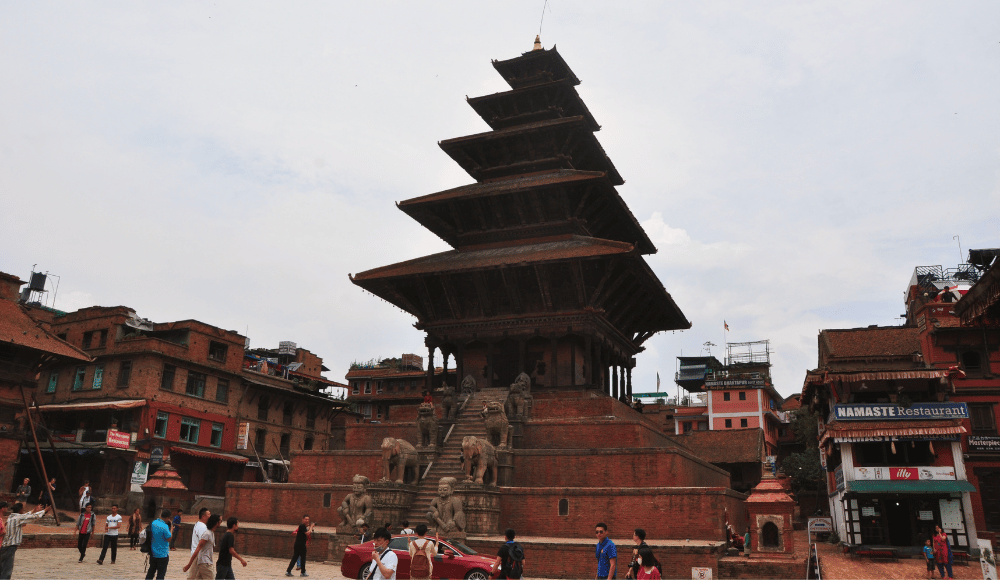
The roofs of the Nyatapola Temple are decorated by carvings of less brutal reincarnations of Siddhi Laxmi. She is believed to be a brute but just a goddess who even Bhairav himself was frightened of. The inside of the temple is closed off to visitors, but it is believed to hold an idol of Siddhi Laxmi, painted all black with 8 heads and multitudes of hands, each hand holding weapons, chakras, and demon heads.
One can admire the less intimidating idols of the goddess outside the temple, surrounded by other beautifully carved details. As you continue looking around the temple, with fresh cool air hitting your face and a view of the entire square in front of you, you will find Nyatapola Temple truly mesmerizing and enchanting.
If you are in Bhaktapur during mid-April, get ready to experience one of the biggest Newari festivals of Kathmandu Valley- the Bisket Jatra. This 9-day extravaganza is packed with a host of fascinating rituals and traditions deeply rooted in ancient local beliefs and superstitions. While many see it as the New Year celebration of the Bikram Sambat calendar, it holds deeper significance for the Newar communities of Bhaktapur and Thimi.
Bisket Jatra, locally called Biska Jatra, is all about celebrating the legends of the Kathmandu Valley, particularly the myths about the death of the serpent. There are several stories revolving around the origin of this festival, which you should explore while you are there. The Bisket Jatra starts on Chaitra 27 and ends on Baishakh 5. The festival is brought alive by tug-of-war played by the locals of Bhaktapur on the very first day to bring the Chariot of Bhairav into their area. Whoever wins takes the chariot to that side of the city.
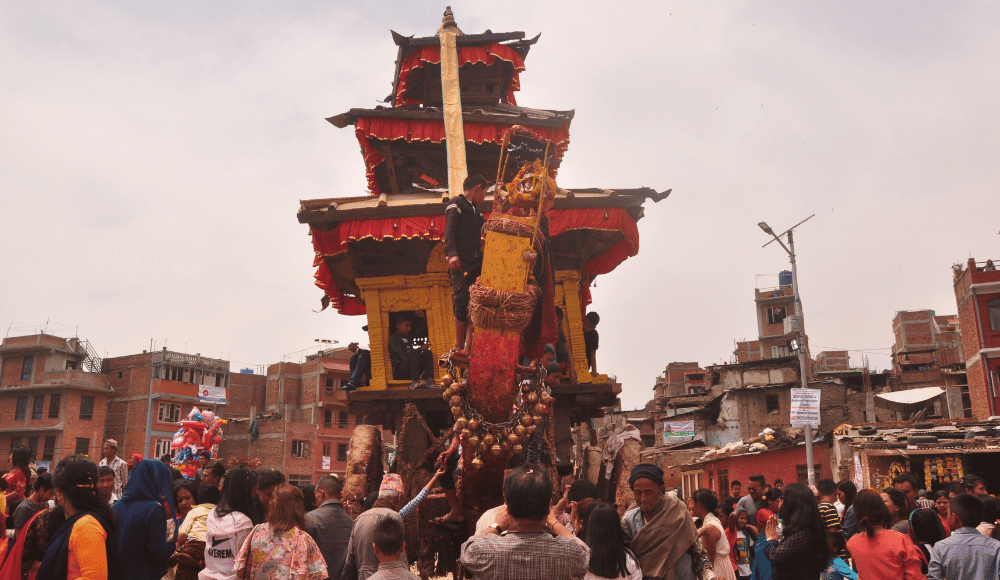
For the next 3 days of Bisket Jatra, the head priest worships Bhairava and people are allowed to bring offerings for the god. On the day of the Nepali New Year, the chariot of lord Bhairava is pulled around different localities of Bhaktapur, followed by music, dancers, and locals with fruits, foods, and animals as offerings. A tall linga is pulled on the previous day which is associated with the luck of Bhaktapur for the coming year. Taumadhi Square is full of life with music, colors, and many many people on that day.
In Thimi, Sindur Jatra is celebrated on the second day of the new year along with the tongue-piercing festival. Everyone gathers around, puts vermilion (sindoor color on each other, and celebrates it with huge passion. A volunteer gets his tongue pierced with spikes as per the tradition and walks around the town shouldering a rack full of flaming torches. Many households bring out their small chariots to celebrate together.
On the last days, another round of tug-of-war is played with the chariot before returning to the Nyatapola temple where it is dismantled until the next year’s celebration.
The Gai Jatra festival is celebrated by the Newar community throughout Nepal, especially in the Kathmandu valley. It is a vibrant and colorful celebration observed with great enthusiasm, believed to have originated from the Lichhavi era. Gai Jatra is celebrated in memory of deceased family members and to avoid the fear of death. The festival is also known as the "Festival of Cows" as it is believed that a cow (holy in Hinduism) can guide the souls of the deceased to the afterlife.
One of the unique aspects of this festival is the procession called the Taha-Macha. Taha Macha includes the construction of a chariot made of bamboo which is pulled through the streets by the participants of the procession. The chariot is decorated with colorful fabrics, flowers, and paper mache figures. Performers dressed in Haku Patasi, wearing masks and face paint also take part in the march, performing dances and songs, adding to the overall festive atmosphere of Gai Jatra.
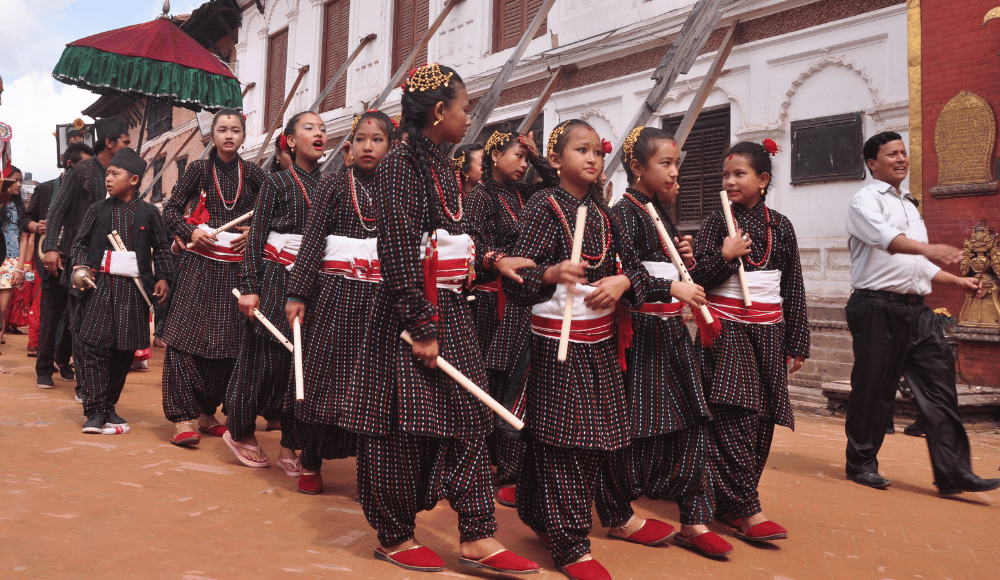
The festival not only serves as a way to remember the deceased, but also uses satire, humor, and irony to address societal injustices. The Ghinta Ghisi dance, which is performed for a week during the festival, is another interesting aspect of Gaijatra, featuring stick-hitting games. The dance is performed by young men who dress in traditional attire and hit each other with sticks as part of the performance.
Gai Jatra is unique in the way it brings people together and allows for the expression of freedom of speech through its various traditions and customs. Diversity and peace are uniquely symbolized in the festival, making it a perfect celebration for people of all ages and backgrounds to participate in and enjoy.
Bhaktapur Durbar Square is surrounded by three other majestic squares, and many more places worth your time;
|
1. |
Taumadhi Square |
|
2. |
Dattatraya Square |
|
3. |
Pottery Square |
|
4. |
Chaar Dham Temples |
|
5. |
Vatsalya Durga Temple and Taleju Bell |
|
6. |
Chyasalin Mandap |
|
7. |
Statue of Bhupatindra Malla |
Taumadhi square is the center of all festivals of Bhaktapur. It is the second most important square after the Durbar Square, consisting of the 5-story Nyatapola temple, Bhairabnath temple, and many other architectural marvels in a wide open complex. Because of its cultural and historical importance, Taumadhi (Ta: Maari) square is filled with people touring or going about their daily rituals. You can simply stroll through souvenir shops in the alleyways or seat on one of the plinths of Nyatapola temple, enjoying the breeze and majestic view of Bhaktapur.
Dattatraya Square is one of the oldest squares in the entire Kathmandu Valley. Named after a deity considered to contain quirks of TriDeva; Brahma, Vishnu, and Maheshwor, this square was a major attraction for trade in the early 14th to 15th century. Dattatraya square is home to several temples and tourist spots including Dattatraya temple, Bhimsen temple, Peacock window, Woodcarving museum, Brass and Bronze museum, etc. Dattatraya square is an example of the true art and beauty of ancient Bhaktapur.
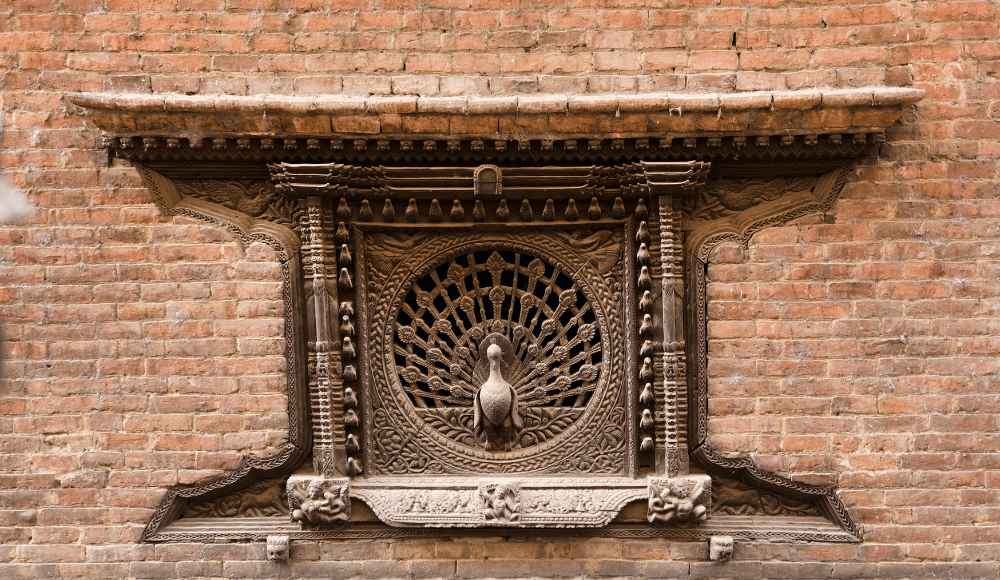
Peacock Window is the finest example of Newari art. Also called the Monalisa of Nepal, it was carved in the 15th century. The peacock window consists of several intricately carved birds forming a frame, inside which you can see a splendidly carved peacock with its feathers spread out. It is located beside the Woodcarving museum, only a lane away from the Dattatraya Temple.
Pottery square, as its name suggests, is the center for pottery making and selling. You can see rows and rows of clay pots left to sun-dry and other rows of fully dried and decorated pots up for sale. Of course, you can also try your hand at pottery in one of those potters’ wheels and even train if you wish to get better. Besides pottery, the pottery square also offers you glimpses into the Astamatrika idols and during Biska Jatra, it holds the ceremony of rising and deflecting the lingo (tall pole).
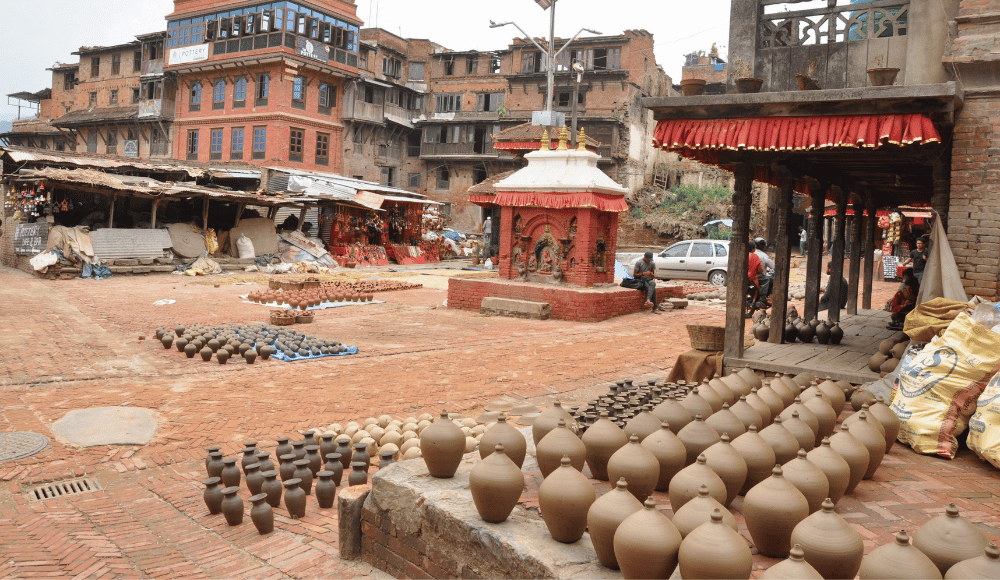
The Char Dham temples were built in durbar square to provide spiritual relief for the pilgrims unable to travel to India due to various reasons. They can instead visit the 4 temples located at the western end of Bhaktapur Durbar Square. Gopinath temple and Badrinath temple are dedicated to Lord Vishnu and his incarnation as Narayan and Krishna. The other two temples out of the Char Dham temples, i.e Rameshwor and Kedarnath Temple are dedicated to Lord Shiva. All of these temples have beautiful idols and carvings related to the gods they represent and their holy deeds.
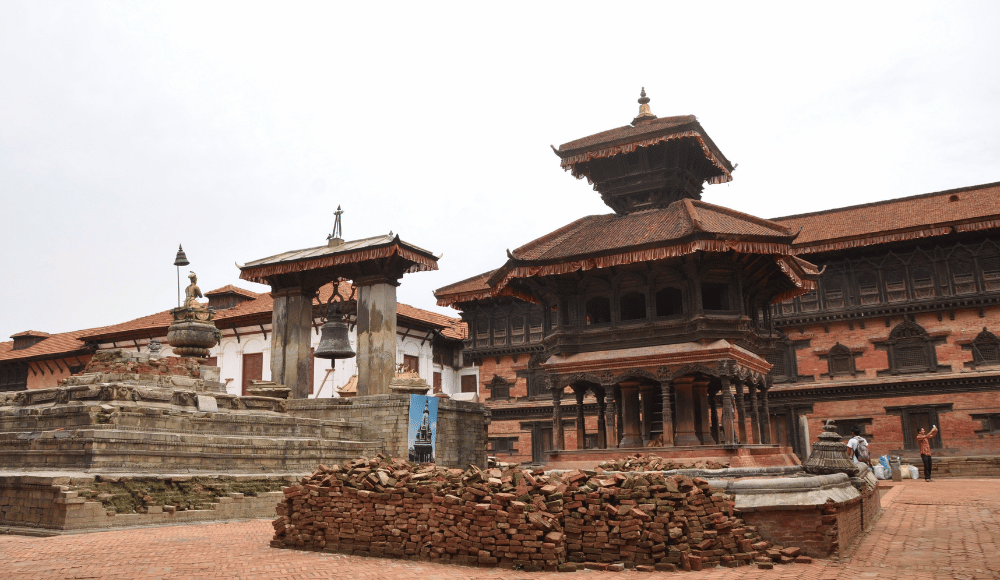
All of these squares, along with the aforementioned temples lie within walking distance from Bhaktapur Durbar Square holding the stories of locals and royals alike. They will undoubtedly make your visit tenfold better so don’t forget to give them all a visit and have a memorable trip.
Bhaktapur Durbar Square is not called the cultural hub of Nepal for nothing. It is the melting pot of Hindu and Buddhist traditions brought to Nepal in different eras by different rulers. All those traditions have been incorporated together regardless of their original dissimilarities. As you walk through the square, you’ll feel a wave of connection with the past and present, preserving the city for ones to come.
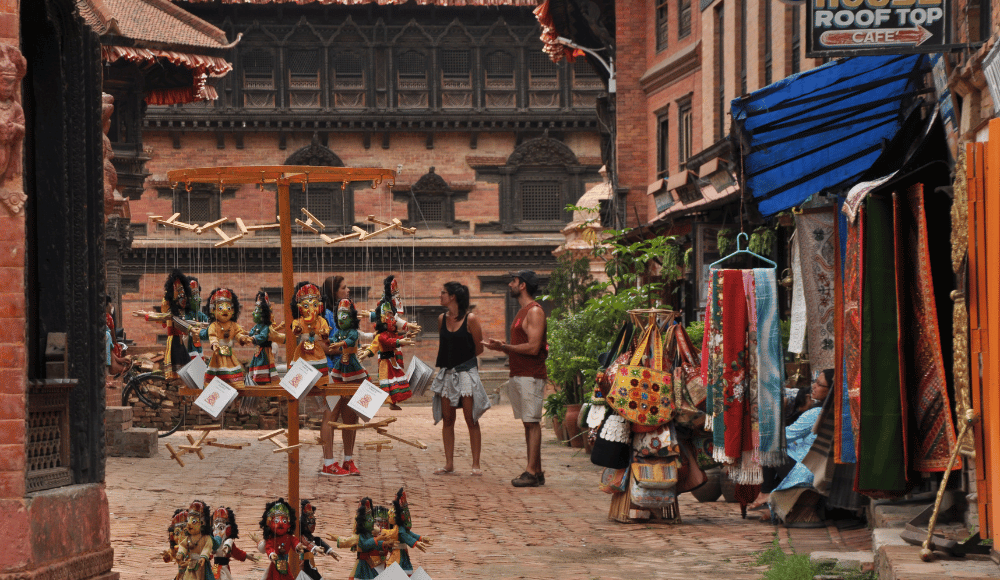
The indigenous people of Bhaktapur, i.e Newari community is widely known for their huge celebrations and Jatras. In Bhaktapur, they take on a whole new level. Bisket Jatra, Gai Jatra, Nava Durga Jatra, etc are just to name a few. Bhaktapurians celebrate such festivals throughout the year with the same enthusiasm and participation. For them, festivals mark their seasons and cultural practices mark their days.
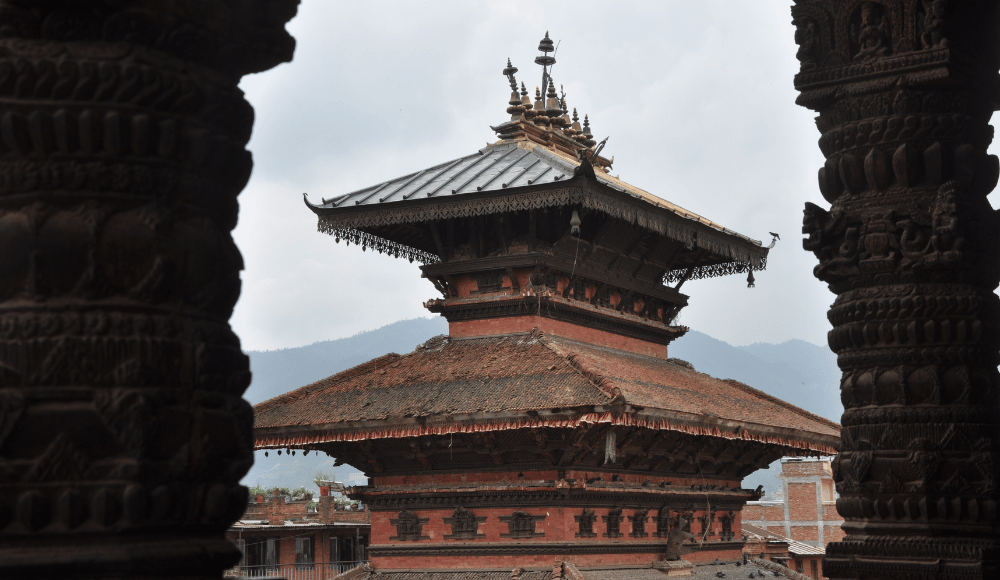
The Nyatapola temple, Golden Gate, Taleju Temple, National Art Museum, etc are live testaments to the thriving religious heritage of Nepal. Their designs and the story they speak through their decors and carvings are unmatched. These monuments keep not only Bhaktapur but also all of Nepal’s culture alive. If you are a history buff, a culture and religion enthusiast, or a simple wanderer, it is a perfect place for you. Far from the dusty streets of Kathmandu, Bhaktapur Durbar Square will make you feel tranquil, curious, and amazed, all at the same time.
The best time of the day to visit Bhaktapur Durbar Square would be early in the morning or late in the afternoon. Visiting early in the morning will allow you to beat the crowds and have the square to yourself for a little while. You will also see the beautiful temples and palaces bathed in the warm light of the rising sun.
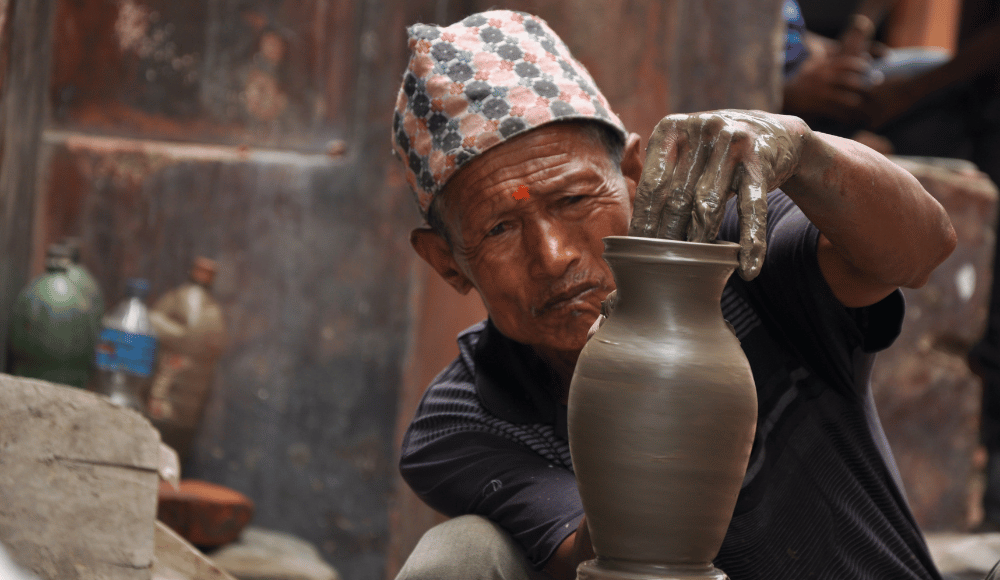
In the morning, you will be greeted by people going about their daily prayers in the temples there. Besides the locals, you will hardly see any crowd in the square. Visiting late in the afternoon is also a great option, as the light is soft and warm and the crowds have generally thinned out by this time. Additionally, the temples and palaces take on a different character as the sun sets, casting long shadows and creating a unique atmosphere.
It's worth noting that the square is closed during the afternoon on Tuesdays and Saturdays for cleaning and maintenance. Whichever time of day you choose to visit, make sure to allow yourself enough time to explore the square and take in all of its beauty. And don't forget to bring a camera, as there will be plenty of opportunities to take beautiful photographs.
Bhaktapur has located 13 km (8 miles) east of the city of Kathmandu. There are several ways to reach there, which I have briefly mentioned below:
By bus: Regular buses run from Kathmandu to Bhaktapur from NAC, Ratnapark, and Baneshwor stops. The journey can take anywhere between 40 minutes to 1 hour depending on the traffic condition.
By car: You can also hire a taxi or car from anywhere in the valley. The trip will take less than an hour, taking you through several towns in the suburbs. It is definitely much more comfortable than traveling by bus but might be a bit costly.
By bike: You can bring your bike or rent one from one of the many bike rental shops in the valley. As bikes are allowed inside the square, you can enjoy a guided bike tour in and around the Bhaktapur Durbar Square.
The roads are well paved and smooth on most parts but it's always advisable to check the actual situation with your trip advisor for a smooth visit without any hiccups.
Like the other Durbar Squares of Kathmandu Valley, Bhaktapur Durbar Square is open 24/7 for a general stroll. But the ticket counter opens only after 7 am till 7 pm all days of the week. Museums each have their separate schedule for different days of the week. Similarly, the square might be closed on some days for cleaning and maintenance. Make sure you inquire about that with your tour guide before confirming your visit.
|
SAARC (and Chinese) National |
NPR 500 Per Person |
|
Other Nationals |
NPR 1500 or $15 Per Person (free for children below 10 years old) |
|
National Art Museum (covers Brass and Bronze Museum and Woodcarving Museum) |
Foreigner NPR 150 SAARC NPR 50 Nepalese NPR 25 |
The National Art Museum charges an extra NPR 100 for a normal camera (NPR 50 for SAARC nationals) and NPR 200 for a movie camera (NPR 100 for SAARC nationals). There is no charge for children below 10 years old to enter the square, however, you’ll still have to pay for entry to the museum. You should also keep in mind that the museums are closed on Tuesdays.
Check the schedule of the square before planning your visit and make sure it's open on the day you want to go. Also, note that the square is closed on certain days for various ceremonies and festivals.
Bhaktapur Durbar Square is a religious site, and visitors are required to dress modestly. Remove your shoes and leather accessories before entering if required by the temples and shrines.
Do not touch or climb on any religious artifacts or monuments, and be respectful of the local customs and traditions. Some customs may be against your beliefs but keep in mind it’s their culture and traditions. Be respectful and attentive to your surroundings and follow all required rules.
Bhaktapur offers a wide range of food varieties that you should not miss at any cost. The Juju Dhau(King’s curd), Yomari, different varieties of Bara and of course momos. Try everything that your belly can hold and enjoy.
Bhaktapur Durbar Square holds so much more than what you can possibly see on a map. So take a little detour and explore the local Gallis(alleyways), visit the not-so-popular sites, and enjoy the unseen sides of Bhaktapur.
The square can get crowded at times, especially during festivals and other events. Be sure to keep an eye on your belongings and be aware of your surroundings to ensure a safe and enjoyable visit.
A local guide can provide valuable insights and information about the various landmarks and attractions in the square and can help you understand the cultural and historical significance of the area.
Bhaktapur Durbar Square is a unique blend of culture, history, and art. Indulge yourself at the moment, have a good time, and enjoy the experience.
Bhaktapur Durbar Square is famous for the 55 Window Palace, National Art Museum, former Palace courtyards, Naga Pokhari, and many other architectural and cultural marvels. It is also known for Juju Dhau, Yomari, and other local cuisines that are sure to make your mouth water.
Bhaktapur is also known as Bhadgaon and Khwopa by locals. You can guess where Bhadgaole Topi originated from.
You can visit the Pachpanna Jhyale Durbar, otherwise known as 55 Window Palace along with the Taleju Temple, Golden Gate, the National Art Museum, Naga Pokhari, etc. While you are at the Bhaktapur Durbar Square, you can take a little detour to visit the nearby squares and temples such as Nyatapola Temple, Dattatraya Temple, Peacock Window, Pottery square, etc.
Juju Dhau, a super sweet cream curd translating to King’s curd, is definitely the most famous food among visitors. You can also try Yomari, steamed buns made up of rice flour filled with either Khuwa or Chaku. Newari Khaja sets from one of the many local food corners will never disappoint you.
The pottery square lies only a little distance away from the main durbar square. In the pottery square, you can learn pottery long-term or just for fun for a day. You can also ask for customized pieces to be made by local potters.
Panch-Tale literally translates to five-storied in the Nepali language. As the Nyatapola temple has 5-story, those unaware of its official name started calling it the Panch-Tale Mandir. It is also called Batashe (windy in Nepali) temple by some people referring to the continuous breeze one can feel when sitting atop the temple compound.
Bhaktapur Durbar Square was listed as a World Heritage Site in 1979 AD.